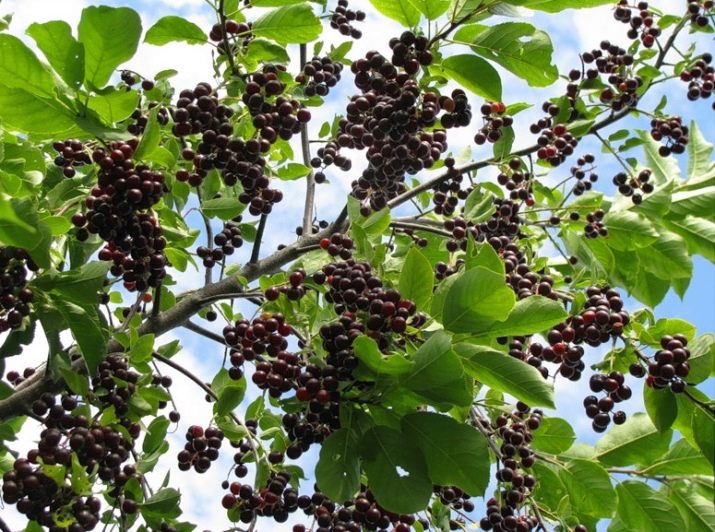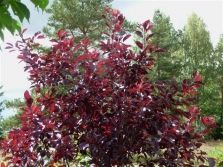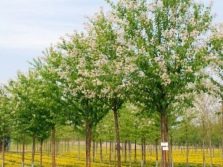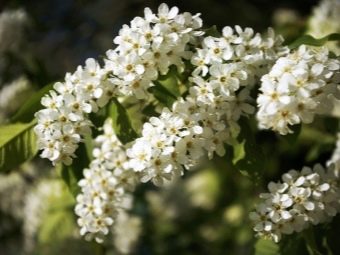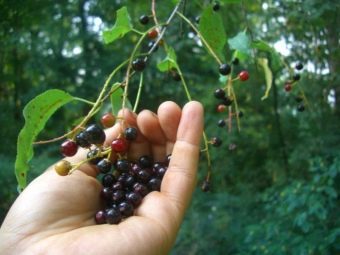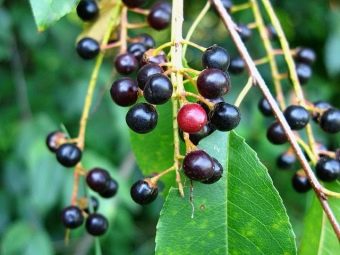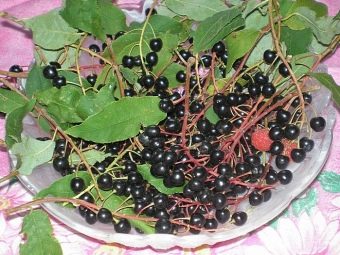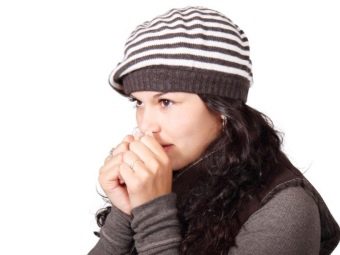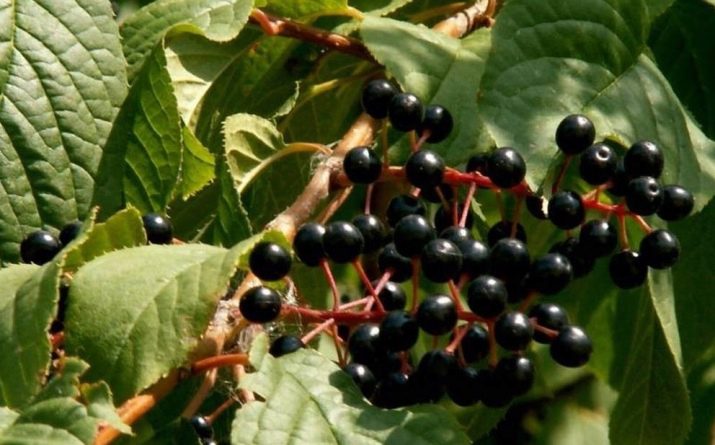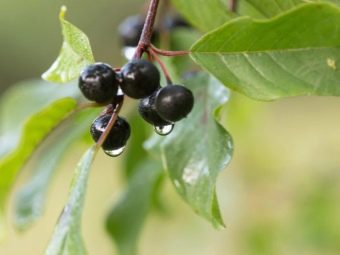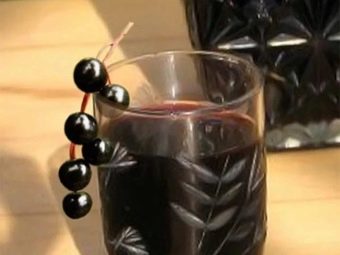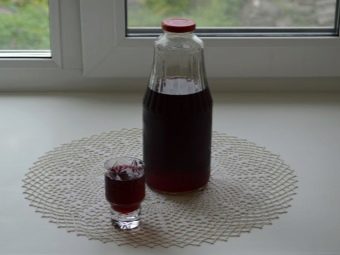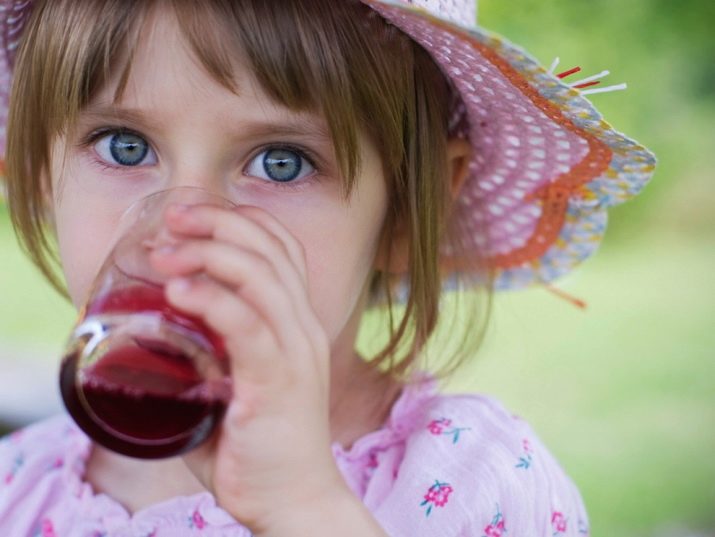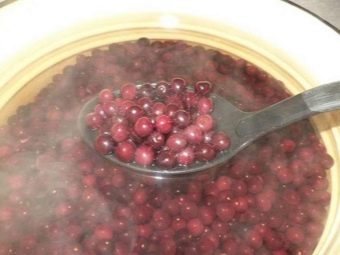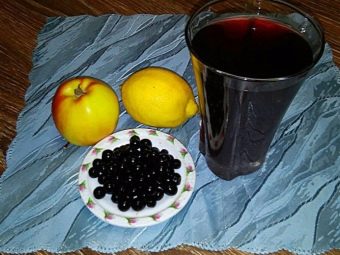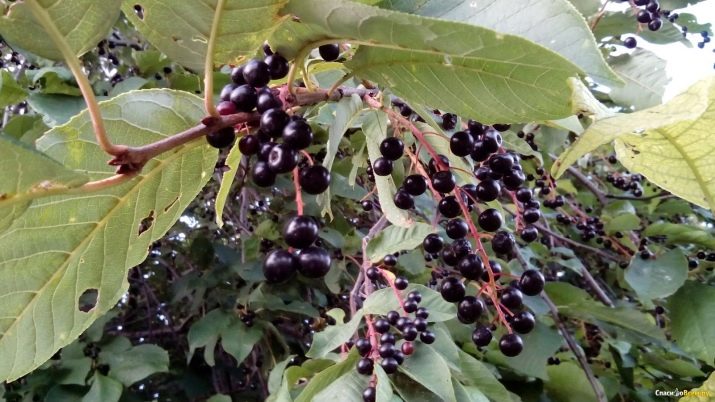Bird cherry berries: benefit and harm, recommendations for use
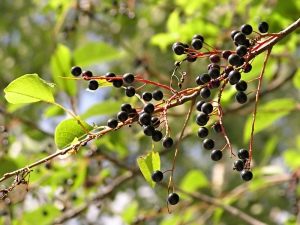
The bird cherry is a beautiful plant that is associated with the Russian people. It is valued for its ornamental species, especially during the flowering period, it is planted in gardens to enrich the vitamin and mineral composition not only in summer but also in winter, it is harvested to give culinary dishes a refined taste. But the bird cherry is valued in Russia due to its wide spectrum of action in medicine, thanks to its rich composition, folk healers cured people of various ailments.
Plant description
The bird cherry is a deciduous shrub that is very similar to a tree, since it reaches a height of up to 10 meters. There are several types:
- ordinary;
- late;
- maaka;
- pennsylvania;
- virginian;
- antipka
At the hearing, everyone knows only the ordinary species and the late bird cherry. In fact, on the territory of Russia, Ukraine, Belarus and Moldova, and you can also meet in Asia each of these types of bird cherry. They differ only in the shape and color of the inflorescences, as well as in the size of the fruits.
There is some conflicting evidence as to what genus this plant belongs to. Some sources claim that the bird cherry belongs to the genus of plums, others say that it is a type of cherry and, at the same time, the family of the Rosy shrub.
Anyway, this shrub prefers rich in minerals, moist soil, next to which there is groundwater, which is why you can often find it near rivers. The stem of the plant is thin, covered with a matte grayish bark. The leaves are elliptical in shape, pointed at the end, with short petioles, bright green color.
The flowers are small, clustered in oblong brush. Most often you can find white inflorescences, but there are also pink. The smell of bird cherry during flowering is strong, fragrant. Flowering tree in late May and early June.
Fruits of a bird cherry roundish, black color. In the middle is a large, round bone. The taste is sweet and slightly astringent. The flesh is saturated purple.
Fruits ripen in late July or early August. Not only berries, but also bark, leaves and bird cherry roots are used as raw materials in various industries.
Useful properties of fruits
Berries of a bird cherry are of very small size, but they are called a storehouse of vitamins and minerals. They include the following components:
- tannins up to 15%;
- hydrocyanic acid to 0.1%;
- organic acids: citric and malic;
- vitamins: rutin, ascorbic acid;
- Sahara;
- anthocyanins;
- essential oil;
- flavonoids;
- fixed oils;
- benzoic aldehyde;
- phytoncides;
- glycosides - prunazin, amygdalin, prulaurazin.
Beneficial features:
- the bactericidal effect is characterized by the presence in the fruits of a large amount of citric and malic acid, as well as phytoncides;
- fungicidal and insecticidal properties formed by ascorbic acid;
- tanning agents provide astringent action;
- anti-inflammatory effect occurs due to anthocyanins, organic acids and essential oil;
- flavonoids and glycidesides provide diaphoretic and diuretic effects;
- tonic property forms a set of vitamin composition and phytoncides;
- disinfecting effect due to hydrocyanic acid;
- regenerative effect due to the presence in the fruits of rutin, fatty and essential oils;
- anthocyanins, benzoic aldehyde have a analgesic effect;
- Immunostimulating properties are provided by vitamins, phytoncides and minerals.
Due to such a large number of various substances, bird cherry is used to treat the following diseases:
- disorders of the gastrointestinal tract - non-infectious nature of diarrhea, impaired gastrointestinal motility, increased or decreased gastric secretion, inflammatory diseases;
- skin diseases: furunculosis, dermatitis, psoriasis;
- ophthalmologic diseases: purulent-inflammatory processes of the eyelids, burns;
- in gynecology used as a contraceptive;
- diseases of the joints: rheumatism, gout, sciatica;
- upper and lower respiratory tract diseases: rhinitis, tuberculosis, bronchitis;
- inflammatory processes in the oral cavity: stomatitis, toothache.
In addition, the bird cherry has a very powerful phytoncidal action, its particles spreading through the air are able to heal the atmosphere, as well as destroy small insects - midges, flies, mosquitoes.
Contraindications
This plant, rich in useful properties, was used in folk medicine many centuries ago, without suspecting that, in addition to its benefits, the bird cherry can also cause harm. As mentioned above, it contains hydrocyanic acid - a substance in large quantities and concentration is a deadly poison. Therefore, it is forbidden to use the berries of bird cherry in large quantities and even more so without stones, since there is the most poison there.
An important contraindication is the increased sensitivity of the body to the components of the bird cherry.
A high content in both the pulp and in the bones, bark and leaves of tannins can cause stool retention, That is why it is not recommended to use in the diet raw bird cherry for people who suffer from chronic constipation.
A high concentration of phytoncides, especially in a flowering tree, worsens the general well-being of especially elderly people. As a result, it is not recommended to enjoy blooming, fragrant bird cherry for a long time if you suffer from migraines, are more susceptible to odors, and also if you have anemia.
Pregnancy and lactation period are relative contraindications, since moderate consumption of cherry fruit will not harm the future and nursing mother, as well as her baby.
Children under 3 years are not recommended to use bird cherry, since a high concentration of substances can cause an allergic reaction or adversely affect the child's gastrointestinal tract.
People who suffer from diabetes use of this berry is also contraindicated due to the high content of sugars in the fruit. If you follow a diet, then you should not enter into the diet of bird cherry, as it is a high-calorie product.
Application features
Since ancient times, healers, using folk medicine, have found an individual approach to each patient, from old man to baby. And they also studied each plant in such detail that the features of the application of each part of medicinal raw materials were found. Today, almost all of these long-standing knowledge has been improved, and the dosage is calculated for each child and adult, depending on the age and characteristics of the diseases. For consuming the fruits of bird cherry there are some features of the reception.
For adults
The safest use of bird cherry is practiced by healthy adults who use berries in the diet for prophylactic purposes. A healthy person per day can eat 250–300 grams of ripe fruit, thus, the body will be enriched with necessary components, and the product will not harm health.
People who suffer from any pathology usually use pharmacy or homemade raw materials from parts of the bird cherry tree. If you purchased the drug cherry in the pharmacy, then be sure to follow the instructions. Many medical drinks are made from it in the form of tincture, decoction, compote, tea, infusion, fruit drink. To do this, use edible ripe berries, you can both fresh and dried, leaves and bark.
Recipes:
- From diarrhea. Take 1 tablespoon of dried fruit and pour 1 cup boiling water. Let the medicine stand for 30 minutes, and then drink 50 ml every day 4-6 times.
- Headache remedy. It is necessary to pour 3 tablespoons of bark with 0.5 liters of boiling water, then put the container on a slow fire and cook until boiling. Cool broth, strain. You need to take 3 times a day before meals for 3 sips.
- To enhance immunity. Bird cherry berries 300 grams Pour 0.5 liters of vodka. Put in a dark place, let it brew for about 20 days.Then strain the drink, and use after eating 1 tablespoon during viral epidemics.
For children
The use of bird cherry for children is somewhat limited. For example, children under 3 years of age are strictly forbidden to use this delicacy. Older can be used at 150-200 mg per day. As a prevention and treatment of childhood diseases make delicious compotes, decoctions, juices.
Basically, for the purpose of treatment, the bird cherry is used for diarrhea, the children are happy to drink a delicious drink, and then soon get rid of an unpleasant illness.
Recipes:
- Compote for the prevention of colds. For 1 liter of water, you will need 0.5 kg of cherry fruit and 300 grams of granulated sugar or honey. Mix all the ingredients, put on a small fire, boil compote for 45 minutes. Cool the drink, after which you can give the child 1 glass 2 times a day, preferably on time or after meals.
- Cherry juice For the juice you need 5 kg of frozen cherry, which you will need to fill with boiled water and put on a slow fire. It is necessary to boil before boiling, so that the berries select the maximum amount of liquid. The drink turns out to be very concentrated, therefore it is best for children to add 1 tablespoon to mineral water or tea.
You can use a different method, but it will cost more than your time. Berries need to remove the bones, then skip the pulp through a juicer, dilute a little with water and bring the drink to a boil. When the drink is ready, you can use it, following the above instructions for receiving.
During pregnancy and breastfeeding
Some sources say about the strict prohibition of taking cherry during pregnancy. But there is evidence that pregnancy and breastfeeding is a relative contraindication. In these conditions, it is best to consult a gynecologist and a pediatrician.
Reception bird cherry should be in any case, in small dosages. It is best to use fresh berries or compote in small quantities. When breastfeeding, it is necessary to introduce the bird cherry into your diet gradually over 3 months, and it is by that time that the baby needs the auxiliary components, which it receives with milk for better growth.
Useful tips
It is important to remember that before applying the fruits of bird cherry, you must follow the following rules:
- use only ripe berries fresh;
- it is strictly forbidden to eat the whole fruit, the bone must be thrown;
- do not abuse a large number of berries;
- for the prevention and treatment of bird cherry, consult a doctor to choose an individual dosage for you;
- if you plan to independently prepare raw materials for the winter, use only whole and fresh fruits, leaves, bark, follow proven technologies of canning or drying, store in a dark, dry place;
- when applying raw materials for therapeutic purposes, follow the required concentration of the drug and the proportions in home production.
See more on the benefits of bird cherry in the next video.

